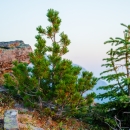Questions and Answers: Whitebark pine listing as Threatened and 4(d) rule
December 14, 2022
Related: News Release - Whitebark pine receives ESA protection as a Threatened species
---------------------------------------------------------------------
What Endangered Species Act (ESA) protections will apply to the whitebark pine listing as threatened?
- It is unlawful to commit, to attempt to commit, to cause to be committed, or to solicit another to commit the following acts for whitebark pine:
Removal from federal lands
Malicious damage or destruction on federal lands
Engaging in interstate or foreign commerce
Import or export (into, out of, or through the U.S.)
Do protections apply to whitebark pine on private lands?
- No, unlike on federal lands, it remains legal to remove or possess the whitebark pine on non-federal lands per the ESA, as long as those activities are otherwise allowed under state law. This includes activities such as propagation, cutting, and seed collection on non-federal lands.
What is the Service doing to help conserve the whitebark pine now?
- The Service is working with Tribal, federal, state, and non-profit organizations, including the Whitebark Pine Ecosystem Foundation and American Forests, to promote the conservation of whitebark pine on the landscape. The Service will also develop a recovery plan for the species; learn more about the recovery process here.
Do grizzly bears need whitebark pine to survive?
- No, while grizzly bears consume whitebark pine seeds, research demonstrates that grizzly bears are generalists and will adapt their food sources regardless of whitebark pine.
Are incidental take permits needed for listed plants?
- On non-federal lands there are no prohibitions under the ESA for the removal, possession, or destruction of listed plants, unless the action in question violates state law.
What types of activities are excepted under the 4(d) rule?
- Some activities are allowed under the current 4(d) rule because they are not considered to be a stressor or threat to whitebark pine. These include any activity with a permit under ESA regulations for permitting take of threatened plants (50 CFR 17.72); forest management, restoration, or research conducted or authorized by a federal agency; removal, cutting, digging, damage, or destruction on non-federal lands by a qualified agency or State employee; or with a cooperative section 6(c) agreement; and Tribal collection of whitebark pine seeds from federal lands for traditional consumption or ceremonial use. Forest management, restoration, or research-related activities may include, but are not limited to, silviculture practices and activities that address fuels management, insect and disease impacts, vegetation management in existing utility rights-of-way, and wildlife habitat management (e.g., full or partial suppression of wildfires in whitebark pine communities, allowing wildfires to burn, survey and monitoring of tree health status).
When is a consultation needed under Section 7 Section 7
Section 7 Consultation
The Endangered Species Act (ESA) directs all Federal agencies to work to conserve endangered and threatened species and to use their authorities to further the purposes of the Act. Section 7 of the Act, called "Interagency Cooperation," is the mechanism by which Federal agencies ensure the actions they take, including those they fund or authorize, do not jeopardize the existence of any listed species.
Learn more about Section 7 of the ESA for whitebark pine?
- Section 4(d) rules cannot, and do not, absolve federal agencies of their consultation requirements under the ESA. When a listed plant may be affected directly and/or indirectly by a project, and there is a federal nexus, federal agencies must fulfill relevant Section 7 consultation requirements. Programs and project examples include: National Environmental Policy Act (NEPA) projects; Clean Water Act, Section 404 permits; and Natural Resource Conservation Service funded projects on private lands. Connected actions on private lands should be considered in analyses of federal projects, even though the action agency may not have jurisdiction over the activities occurring on private lands.
The trigger for consultation is whether a federal action may affect a listed species or its critical habitat, not whether the action would result in prohibited damage or destruction under a 4(d) rule. Consultation is required to ensure that the activity will not jeopardize the species to satisfy the requirements in section 7(a)(2) of the Act. If a federal agency’s action may affect whitebark pine, they must fulfill Section 7 consultation obligations under 50 CFR part 402. Even if an activity is excepted under the 4(d) rule, a federal agency that determines their action is likely to adversely affect a listed species or its critical habitat must pursue formal consultation with the Service. Additionally, if a federal agency determines that their action is not likely to adversely affect a listed species or its critical habitat, they must still receive the Service’s written concurrence, even if this activity is excepted under the 4(d) rule.
However, even though 4(d) rules do not remove or alter Federal agencies’ Section 7 consultation obligations, the Service is in the process of developing tools to streamline consultation on federal actions that may affect the whitebark pine and are consistent with the provisions of the 4(d) rule.
When is a Section 10(a)(1)(A) permit needed?
- Section 10(a)(1)(A) permit is needed if a recovery or research effort involves removing plants, plant parts, or seeds from federal lands; or if using federal funding for the effort. Survey and monitoring efforts that do not result in the removal of plants do not require a section 10(a)(1)(A) permit. More information about Section 10(a)(1)(A) permits is available on the Service’s website.


